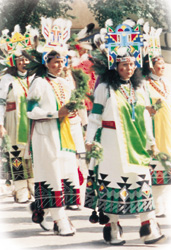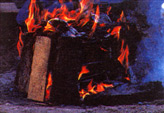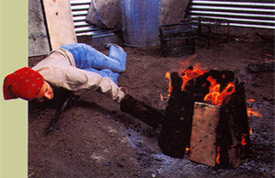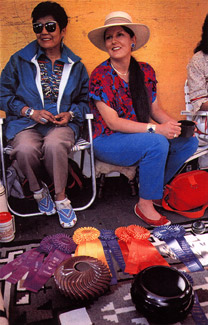|
The Old Ways
Creating the Pot
Cornmeal offerings and prayers of thanks to the earth for her gifts begin with the gathering of the clay. The Tafoya family traditionally gathers to dig their clay in September or October on Santa Clara Pueblo land, bringing their trucks and a picnic lunch. The male counterparts of the family help with the task of gathering and preparing the clay. It is arduous work. They collect enough clay for several years of pottery making.
The clay is spread out, broken into small pieces, dried thoroughly, and then put in trash cans to soak in water, which causes impurities to rise to the surface to be skimmed off. Then the clay is run through a fine mesh screen to take out pebbles and other impurities. It remains outside for a few weeks and excess water is ladled off. The "sand", or volcanic ash, is collected at Pojoaque Pueblo and also is run through a fine mesh screen.
The clay and sand are mixed in traditional proportions and then stored in plastic to maintain a proper degree of hardness. Before starting a pot, balls of clay are squeezed and pounded to push out all the air bubbles. The clay slip used for a pot to be fired red, will differ from that used for a pot going through the reduced-oxygen firing stage to turn black. Nancy finds that the clay for a black pot will polish to a higher finish.
 In traditional fashion, Nancy rolls coils of clay between her palms and starts the base of the pot over a shallow bowl called a puki which is removed when the finished pot begins to harden. When she made only miniatures during the 70s and early 80s Nancy used a small coil of clay the size of a Cheerio for making pieces. In traditional fashion, Nancy rolls coils of clay between her palms and starts the base of the pot over a shallow bowl called a puki which is removed when the finished pot begins to harden. When she made only miniatures during the 70s and early 80s Nancy used a small coil of clay the size of a Cheerio for making pieces.
After coiling, Nancy shapes her pot with tools that may range from a sawed-off spoon to a tongue depresser. Once the coils are smoothed and shaped to a satisfying form, the pot is wrapped in plastic to pull out the moisture and stored until it has reached a "leather hardness" suitable for carving. Aside from design ideas, carving is Nancy's favorite step because her creativity is challenged. She estimates that the carving hours for one pot may total more than a hundred. She first pencils in the motifs, a band design, or the location of ridges for a melon bowl.
Nancy divides an S-swirl melon jar vertically into thirds, carving first the top third of the curve, then reverses the diagonal and carves the middle section, turns the angle back and carves the bottom third of the pot. Nancy finds that her jars and bowls with straight ridges from top to bottom are the hardest to make perfectly, as the ridge lines must be absolutely perpendicular all around. The slightest slant of one ridge would stand out in the finished piece. Carving tools include exacto knives, screwdrivers, and an old camping knife of her mothers which is a favorite tool that fits comfortably in her hand.
The pot is then dried completely before sanding is begun. Although corncobs were the traditional sanding tool at Santa Clara, Margaret Tafoya began using sandpaper years ago which the family potters continue. Using many grades of sandpaper from rough to fine, Nancy will devote hours to the sanding of a pot. When sanding is complete, she dusts all the crevices and surfaces with a damp sable brush to achieve a uniform surface texture. The piece must then dry for at least a day before several coats of a tawny colored slip are painted on the pot section to be polished. The slip soaks into the clay in preparation for polishing.
Polishing is a tedious stage of intense concentration, and the pot must be handled with extreme care due to its fragility before being fired. Nancy's need for perfection of polish allows for only three ribs of a melon jar to be polished in a three-hour stint. An even all-around polish is most difficult with the S-swirl ribs. Nancy estimates that a 64-ribbed bowl will require five or six twelve hour days to polish to her satisfaction. Her polishing stones include a smooth black stone called "Apache Tears", which belonged to great-grandmother Sara Fina, and several small flat pointed stones whose shapes fit exactly into the deep ridges of her melon jars. Recessed areas and surfaces not to be polished are painted with a matte slip.
While Nancy may be working on a number of pieces at different stages of completion, the total time from coiling one pot until it is ready for firing may take several months.
Firing the Pot
 Nancy fires each piece in the traditional way using an open pit that resembles that of a campfire. Early on, she would fire outside being vulnerable to wind and rain. The elements can dictate how successful a firing will turn out.Since then, she's designed and built her own enclosed firing house at the pueblo making weather concerns minimal, yet still keeping with tradition.
Nancy fires each piece in the traditional way using an open pit that resembles that of a campfire. Early on, she would fire outside being vulnerable to wind and rain. The elements can dictate how successful a firing will turn out.Since then, she's designed and built her own enclosed firing house at the pueblo making weather concerns minimal, yet still keeping with tradition.
 Even so, timing and experience are everything and through the years she's pushed the limits of her expertise to the ultimate.
After preparing, polishing and carving a piece (which could take anywhere from 50 to 300 hours) in this final process there's always that chance of the piece cracking and sometimes exploding. There are no gauges to let you know when the piece is ready
to birth from the flame. "You have to leave as little to luck and chance as is humanly possible. At some point the spirit of the Clay Mother takes over, and you know when to leave well enough alone. Something larger takes command and then you have to let go and trust the process. Even so, timing and experience are everything and through the years she's pushed the limits of her expertise to the ultimate.
After preparing, polishing and carving a piece (which could take anywhere from 50 to 300 hours) in this final process there's always that chance of the piece cracking and sometimes exploding. There are no gauges to let you know when the piece is ready
to birth from the flame. "You have to leave as little to luck and chance as is humanly possible. At some point the spirit of the Clay Mother takes over, and you know when to leave well enough alone. Something larger takes command and then you have to let go and trust the process.
 |
The fire decides its destiny. I use cornmeal before I get my clay and sand, and pray before each firing." Nancy was once asked in an interview why she doesn't fire using a kiln. Her response - "If I bought the clay, poured the clay, stenciled the Native American designs on these pots, or used a kiln, there's nothing there anymore. Tradition stops. Tradition means everything to me, it's in my blood.
|
| The way I do it, is the way I was taught. I give it my all. The piece becomes a part of me and represents who I am." |
|
Her collection of works seem to rise from the earth, and into the hands of the powerful flame that engulfs her creations into its final form. Nancy has achieved a lot, but is still very much the student as well as the teacher, forever learning, continually creating, fulfilling her compelling desire to take her craft further. "Doing this work is like playing a musical instrument, the more you practice, the better you become." Nancy believes that it's important for her to pass on the knowledge of what she has learned. "If I pass it on to my peers, it will not be forgotten. Therefore tradition continues and is not lost through the progression of time. This art, using the old ways,
should be remembered and handed down to the next generation of potters to come." Nancy is always available, as her grandmother was for her, to pass on the knowledge of what she has learned from those who stood before her. "I am, I did, I have and I still am," affectionately giving credit to her grandmother who became her inspiration and her guide. |
| Nancy Youngblood and the Tafoya Family of Santa Clara Pueblo:
Nancy is the great-grandchild of Sara Fina and Geronimo Tafoya of Santa Clara Pueblo. By the beginning of the 20th century, Sara Fina was the first Santa Clara potter to combine the utilitarian form of her large storage jars with simple yet elegant non-functional designs. She began the use of an imprinted bear paw on her pieces which her daughter Margaret has used extensively on storage jars, water jars, and bowls for decades. The bear paw is a symbol of good luck for Santa Clarans, for the bear always knows where to find water. It has become the hallmark of Tafoya pottery.
Sara Fina's signature large storage jars, was her pursuit of excellence. They were her pusuit of excellence in design and polishing. They were a potter's view of perfection. This set an example for Margaret, who learned to make pottery as a child by watching her mother and father. Sara Fina gradually became more innovative in her work, adding fluted tops and rainbow bands to her water jars. Nancy has combined these innovations of her great-grandmother's with her own S-swirl designs in recent years.
| At ninety-six, Margaret Tafoya died, in 2001, she had been the matriarch of pueblo pottery for decades. Her work has spanned the 20th century. The beauty and scale of her large storage jars were famous by the 1960s and she received the Best of Show awards in 1978 and 1979 at Santa Fe Indian Markets. In addition to the bear paw motif, she created the deeply carved bands of pueblo symbols, like the avanyu (water serpent) and kiva steps, around the shoulders of her jars which also became signature motifs of the Tafoya family. Traditional Tafoya pottery is noted for the integration of design with classic shapes, deeply carved motifs with the recessed areas in matte finish, and highly polished surfaces.
The boldness of her grandmother's pots, their incredible polish, and the risk-taking of firing large scale jars have greatly influenced Nancy's development as a potter and her drive for perfection. She considers her grandmother to be the greatest artistic influence on her career and the inspiration for her determination to follow and pass on the traditional means of clay gathering and preparation, creation of the pot, and firing methods. Margaret and her daughter Mela, Nancy's mother, also instilled in her a strong sense of spirituality and the importance of family. |

Margaret &
Alcario Tafoya
Nancy's Grandparents |
Mela Youngblood was an excellent potter who died prematurely in 1990 before receiving the recognition she deserved. When Mela returned to the pueblo with her children in 1968, she became a serious potter, and Nancy began learning by watching her grandmother
and mother. Nancy was always eager to make and fire pots on her own and, learning by trial and error, had frequent failures. Her grandmother and mother were there to answer her many questions.

|
Mela inspired Nancy to broaden her experiences beyond the pueblo and was always there to help Nancy, setting aside her own work to help her fire her pots. Once she was sure her daughter was serious about pottery, Mela encouraged her to enter her work in shows and included Nancy's work in her own exhibitions.
Nancy and her mother, Mela at Indian Market 1989. Nancy won "Best of Show" on her Red Swirl Melon Bowl. |
Other family members who Nancy feels have influenced her development as a potter are cousins Teresita Naranjo for the elaborate carving of her pots, and Grace Medicine Flower for the delicacy of her pots and their designs. She also has a special fondness for her Aunt Berta (Shirley Tafoya,) with whom she lived for a time after high school as starving artists making miniatures together.
When Nancy created her first pots for competition they had traditional Tafoya shapes and designs, but on a miniature scale which satisfied her need to be part of the family traditions yet to be unique, to stand apart. The inspiration for her first S-swirl melon bowl came from an S-swirl melon bowl by her great-uncle, Camilio Tafoya. The ribs of his pot were fewer and thicker, but from that bowl Nancy developed her own version with deeper, more numerous ribs and eventually slanted the swirls like those on the late water jars made by her great-grandmother, Sara Fina. Nancy continued to challenge herself technically as her S-swirl melon bowls evolved. Today this signature bowl has been perfected in her recent large scale pots.
Sara Fina and Margaret Tafoya were married to husbands who not only helped them with the clay preparation and firing of their pots but packed and carried them by burro and wagon to trading posts and railroad stations far away. |
Copyright © Nancy Youngblood Inc.
|

 In traditional fashion, Nancy rolls coils of clay between her palms and starts the base of the pot over a shallow bowl called a puki which is removed when the finished pot begins to harden. When she made only miniatures during the 70s and early 80s Nancy used a small coil of clay the size of a Cheerio for making pieces.
In traditional fashion, Nancy rolls coils of clay between her palms and starts the base of the pot over a shallow bowl called a puki which is removed when the finished pot begins to harden. When she made only miniatures during the 70s and early 80s Nancy used a small coil of clay the size of a Cheerio for making pieces.
 Nancy fires each piece in the traditional way using an open pit that resembles that of a campfire. Early on, she would fire outside being vulnerable to wind and rain. The elements can dictate how successful a firing will turn out.Since then, she's designed and built her own enclosed firing house at the pueblo making weather concerns minimal, yet still keeping with tradition.
Nancy fires each piece in the traditional way using an open pit that resembles that of a campfire. Early on, she would fire outside being vulnerable to wind and rain. The elements can dictate how successful a firing will turn out.Since then, she's designed and built her own enclosed firing house at the pueblo making weather concerns minimal, yet still keeping with tradition.
 Even so, timing and experience are everything and through the years she's pushed the limits of her expertise to the ultimate.
After preparing, polishing and carving a piece (which could take anywhere from 50 to 300 hours) in this final process there's always that chance of the piece cracking and sometimes exploding. There are no gauges to let you know when the piece is ready
to birth from the flame. "You have to leave as little to luck and chance as is humanly possible. At some point the spirit of the Clay Mother takes over, and you know when to leave well enough alone. Something larger takes command and then you have to let go and trust the process.
Even so, timing and experience are everything and through the years she's pushed the limits of her expertise to the ultimate.
After preparing, polishing and carving a piece (which could take anywhere from 50 to 300 hours) in this final process there's always that chance of the piece cracking and sometimes exploding. There are no gauges to let you know when the piece is ready
to birth from the flame. "You have to leave as little to luck and chance as is humanly possible. At some point the spirit of the Clay Mother takes over, and you know when to leave well enough alone. Something larger takes command and then you have to let go and trust the process.


